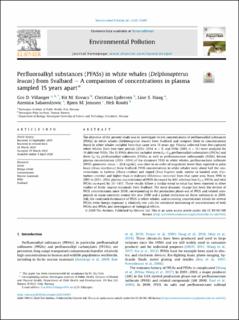| dc.contributor.author | Villanger, Gro Dehli | |
| dc.contributor.author | Kovacs, Kit M. | |
| dc.contributor.author | Lydersen, Christian | |
| dc.contributor.author | Haug, Line Småstuen | |
| dc.contributor.author | Sabaredzovic, Azemira | |
| dc.contributor.author | Jenssen, Bjørn Munro | |
| dc.contributor.author | Routti, Heli Anna Irmeli | |
| dc.date.accessioned | 2021-02-23T09:42:36Z | |
| dc.date.available | 2021-02-23T09:42:36Z | |
| dc.date.created | 2020-09-10T22:15:05Z | |
| dc.date.issued | 2020 | |
| dc.identifier.citation | Environmental Pollution. 2020, 263 (Part A), . | en_US |
| dc.identifier.issn | 0269-7491 | |
| dc.identifier.uri | https://hdl.handle.net/11250/2729695 | |
| dc.description.abstract | The objective of the present study was to investigate recent concentrations of perfluoroalkyl substances (PFASs) in white whales (Delphinapterus leucas) from Svalbard and compare them to concentrations found in white whales sampled from that same area 15 years ago. Plasma collected from live-captured white whales from two time periods (2013–2014, n = 9, and 1996–2001, n = 11) were analysed for 19 different PFASs. The 11 PFASs detected included seven C8–C14 perfluoroalkyl carboxylates (PFCAs) and three C6–C8 perfluoroalkyl sulfonates (PFSAs) as well as perfluorooctane sulfonamide (FOSA). Recent plasma concentrations (2013–2014) of the dominant PFAS in white whales, perfluorooctane sulfonate (PFOS; geometric mean = 22.8 ng/mL), was close to an order of magnitude lower than reported in polar bears (Ursus maritimus) from Svalbard. PFOS concentrations in white whales were about half the concentrations in harbour (Phoca vitulina) and ringed (Pusa hispida) seals, similar to hooded seals (Cystophora cristata) and higher than in walruses (Odobenus rosmarus) from that same area. From 1996 to 2001 to 2013–2014, plasma concentrations of PFOS decreased by 44%, whereas four C9-12 PFCAs and total PFCAs increased by 35–141%. These results follow a similar trend to what has been reported in other studies of Arctic marine mammals from Svalbard. The most dramatic change has been the decline of PFOS concentrations since 2000, corresponding to the production phase-out of PFOS and related compounds in many countries around the year 2000 and a global restriction on these substances in 2009. Still, the continued dominance of PFOS in white whales, and increasing concentration trends for several PFCAs, even though exposure is relatively low, calls for continued monitoring of concentrations of both PFCAs and PFSAs and investigation of biological effects. | en_US |
| dc.language.iso | eng | en_US |
| dc.publisher | Elsevier | en_US |
| dc.rights | Attribution-NonCommercial-NoDerivatives 4.0 Internasjonal | * |
| dc.rights.uri | http://creativecommons.org/licenses/by-nc-nd/4.0/deed.no | * |
| dc.title | Perfluoroalkyl substances (PFASs) in white whales (Delphinapterus leucas) from Svalbard – A comparison of concentrations in plasma sampled 15 years apart | en_US |
| dc.type | Peer reviewed | en_US |
| dc.type | Journal article | en_US |
| dc.description.version | publishedVersion | en_US |
| dc.source.pagenumber | 11 | en_US |
| dc.source.volume | 263 | en_US |
| dc.source.journal | Environmental Pollution | en_US |
| dc.source.issue | Part A | en_US |
| dc.identifier.doi | 10.1016/j.envpol.2020.114497 | |
| dc.identifier.cristin | 1828902 | |
| dc.description.localcode | This article is available under the Creative Commons CC-BY-NC-ND license and permits non-commercial use of the work as published, without adaptation or alteration provided the work is fully attributed. | en_US |
| cristin.ispublished | true | |
| cristin.fulltext | original | |
| cristin.qualitycode | 1 | |

